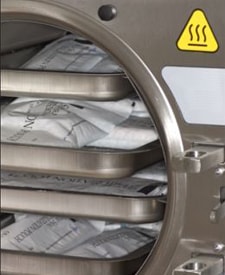The guidance Safety requirements for autoclaves, addresses the risks associated with the safeguarding, training and maintenance of the equipment. It is aimed at all employers, supervisors and managers responsible for its safe operation and maintenance.

An autoclave is a pressure vessel with a lid or door, arranged for regular access. Products placed inside are subjected to pressure, and in most cases, high temperatures. They are used for a variety of processes, including the treatment of waste.
Fatalities
At present only a handful of firms in the UK use the technology to treat waste. One such firm is Sterecycle, which uses an autoclave as part of its waste treatment process at its facility on Sheffield Road in Rotherham.
The HSE first announced that it would be publishing guidance for autoclaves in March 2012 (see letsrecycle.com story).
It said that the guidance has been published in response to two fatalities involving autoclaves in the UK since 2008.
According to the HSEs records of fatalities in December 2008, Allan Sanderson, a worker at an aerospace firm, died after one of the pedestrian walkways collapsed whilst he and another employee were loading the autoclave.
A further incident involving an autoclave happened in January 2011 when an explosion at the Sterecycle site in Rotherham resulted in the death of one man and left another seriously injured (see letsrecycle.com story).
High risk
According to the HSE, autoclaves are high risk equipment. Explaining the risks associated with the technology, the guidance states: The most serious risks come from the uncontrolled release of stored energy, which happens when safety critical parts fail. This can cause violent ejection of: components/pieces of equipment; the pressurising medium; the vessel contents.
The HSEs guidance offers operators a practical step-by-step guide on how to best control and minimise the risks associated with autoclaves, across all industrial applications.
It offers guidance on various scenarios, including:
Related Links
- The difference in control between automated and manual systems;
- Inadvertent pressurisation with a person inside the autoclave;
- The door/ lid opening violently under pressure; and,
- Inadvertent pressurisation of blowdown, drain and transfer lines.
It also offers advice on the instruction and training that should be given to those working with autoclaves. In addition, it looks at the need for maintenance and inspection of the equipment and what this should involve.







Subscribe for free